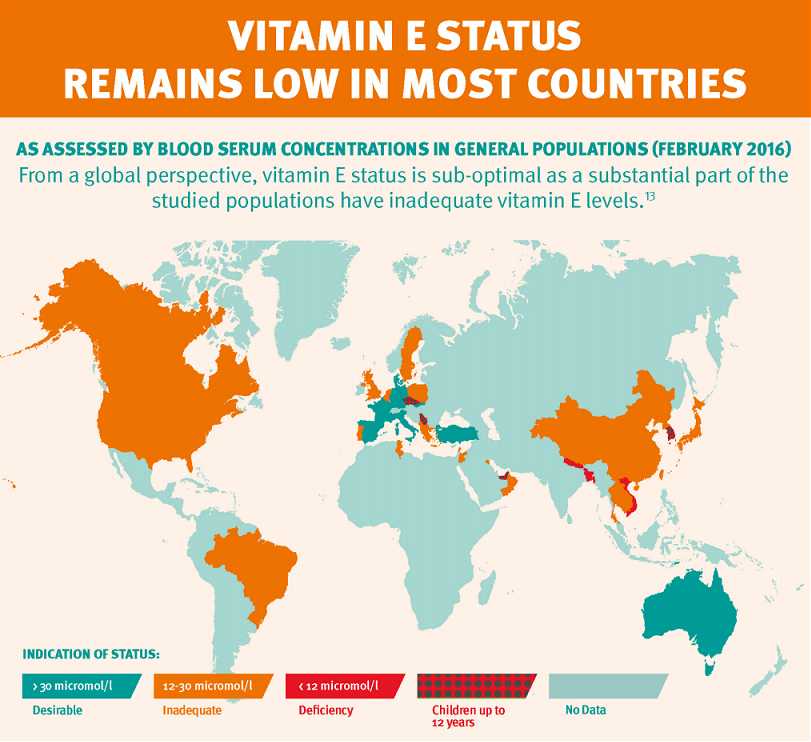A recent study published in the International Journal for Vitamin and Nutrition Research (1) establish that just 21% of the studies of the examined populations globally reach a serum α-tocopherol concentration of ≥30 μmol/L. This is the vitamin E threshold that several studies suggest has major effects on human health in multiple areas. The research is unique, and the first of its kind to review over 170 existing papers worldwide on studies into vitamin E intake levels and serum concentrations. The findings conclude that vitamin E status is inadequate in a substantial part of the reviewed populations. Infographic: Vitamin E status remains low in most countries
 Vitamin E is an essential micronutrient that protects cell membranes from oxidative damage, including those rich in polyunsaturated fatty acids (PUFAs). The higher the level of PUFA intake, the more vitamin E is required. This study finds vitamin E status to be alarmingly low globally. Modern changes in diet may be a contributing factor. Vitamin E status can be increased by eating more foods high in vitamin E, such as vegetable oils, green vegetables, nuts, seeds, whole grain bread; fortified foods and beverages, and dietary supplements.
Vitamin E is an essential micronutrient that protects cell membranes from oxidative damage, including those rich in polyunsaturated fatty acids (PUFAs). The higher the level of PUFA intake, the more vitamin E is required. This study finds vitamin E status to be alarmingly low globally. Modern changes in diet may be a contributing factor. Vitamin E status can be increased by eating more foods high in vitamin E, such as vegetable oils, green vegetables, nuts, seeds, whole grain bread; fortified foods and beverages, and dietary supplements.
Dr. Simin Meydani, Director of Jean Mayer USDA Human Nutrition Research Center on Aging at Tufts University comments: “This global assessment of vitamin E status – the first of its kind – is an important step to generate awareness because so many people around the world do not consume recommended amounts of vitamin E. An adequate vitamin E intake is needed to maintain the immune system, cognitive function, cardiovascular health, and liver function. The findings of the publication suggest that health authorities need to dedicate more attention to the intake, status, and role of vitamin E in human health.”
Applying a Recommended Daily Allowance (RDA) of 15 mg/day and Estimated Average Requirement (EAR) of 12 mg/day to all populations with a minimum age of 14 years, 82% and 61% of data points were below the RDA and EAR respectively. The new paper further reveals that globally 13% of the scientific publications indicated serum concentrations below the suggested deficiency threshold concentration of 12 μmol/L, mostly in newborns and children.
Szabolcs Péter, MD, PhD, Senior Scientist at DSM, and one of the co-authors says: “This comprehensive review of vitamin E dietary intake and serum concentrations demonstrates that the majority of the reported intake values worldwide are below recommended levels. Similarly, it shows that a considerable proportion of the global population do not reach the proposed optimal serum concentration for vitamin E. This study should help stimulate needed research to understand the complex field of vitamin E and its impact on human health.”
The study found that vitamin E intake differed regionally. People living in the Middle East and Africa (27%) were more likely to be consuming below the RDA, but the prevalence was also relatively high in Asia Pacific (16%) and Europe (8%). Considering a threshold concentration of 30 μmol/L recommended by experts, 27% of the American, 80% of the Middle East/African, 62% of the Asian, and 19% of the European populations are below this serum value. On the other hand, only 21% of the total data points included in this global review reach a desirable mean serum concentration of 30 μmol/L or higher. This can be explained by varying diets and nutrient availability across the world.
Reference
1. Szabolcs P, Angelika F, Roos FF, Wyss A, Eggersdorfer M, Hoffmann K, Weber P. A Systematic review of global alpha-tocopherol status as assessed by nutritional intake levels and blood serum concentrations. Int J Vitam Nutr Res 2016. DOI: 10.1024/0300-9831/a000281.